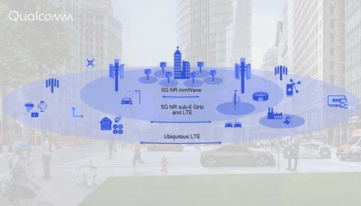With the new 5G ecosystem it is expected that by 2022, 5G mainstream services will include, Connected Homes, IoT, Commercial Drones, Virtual Personal Assistance & Virtual/Augmented Reality.
The above services will require high-performance networks with ultra-fast data rates and strict latency requirements, but also support a wide range of device types with low cost, long battery life, and extensive frequency coverage.
Telecom Operators are currently investigating their network readiness and preparing for smooth migration towards 5G deployment.
5G key enablers
5G key enablers are services that require Massive IoT, Ultra-low latency, higher capacities and increased flexibility via virtualization, slicing and Fixed Mobile Convergence (FMC). FMC is essential to provide the increasing capacity demands with FWA and indoor/outdoor solutions via the convergence of the mobile network and fixed service lines.
In order to prepare for future 5G networks, Telecom Operators will have to cope with unstable conditions and develop a flexible deployment strategy. For efficient 5G deployment, many areas have to be catered for, such as the coverage and radio aspects of 5G networks, the 5G Core and ePC migration, transport design, backhaul requirements, antenna evaluation, small cell deployment, O&M, automation, and security aspects.
5G Deployment Phases
5G Deployment has to be structured in distinct phases. This phased approach enables a market-centric development, where the early 5G deployment is based on existing infrastructure and non-standalone mode to support the first 5G applications according to market needs and network readiness.
The next phase will be the migration phase where additional use cases will be supported with the target to reach full 5G potential beyond 2022 and develop a 5G standalone network with a vast range of 5G services.
5G system principles for early implementation and migration
Initial 5G implementation will focus on the eMBB and FWA applications and will be limited to major cities and specific areas. 5G NR will commence with 3.5GHz, while 700MHz for LTE advanced Pro will provide an intermediate step for 5G networks. Coverage can be maximized by separating DL (3,5GHz) from UL (LTE) at 700MHz. The architecture will remain in the existing distributed fashion and connected to the legacy core ePC network. Initially, combined 2G/3G/LTE/5G sites will be created where additional equipment, such as a new 5G module will be located on the same infrastructure.
The next step, targeted beyond 2020, will be based on FWA, FMC, and low latency applications with less than 5ms delay. This will require a modernized single RAN and the introduction of the RAN aggregation layer. New radio functions will be developed with RAN virtualization, CU/DU split and connection to new core (NGC).
The final step for full 5G deployment beyond 2022 will be based on FMC providing a fully harmonized service deployment for fixed and mobile, enhanced FWA via higher frequencies and point to multipoint beam-forming antennas.
5G Core
A new overlay core, together with multi-access edge computing (MEC) may be required for 5G launch, along with the introduction of a modern virtualized 5G architecture. A new 5G core will use a scalable cloud-native Service Based Architecture (SBA) with SDN/NFV and Network Slicing that separates the control and the user plane to provide efficient service provisioning and seamless user experience over wireless, fixed and converged network technologies.
5G Transport
Whether it is an end-to-end L3 transport network or an initial existing network of hybrid L2 at the access and L3 at the aggregation and core, 5G transport has to support multi-gigabit connectivity. High bandwidth wireless backhaul networks have to be deployed in the new millimeter-wave bands and used in conjunction with advanced techniques such as carrier aggregation between legacy and millimeter-wave frequencies to extend the multi-gigabit coverage.
New wireless systems close to or above the 100GHz frequency range have to be developed to utilize high-bandwidth radio links and support even higher capacities at least for the last mile connections up to the 1km distance range. Transport elements need to support end-to-end phase and time synchronization to meet 5G latency requirements and hierarchical Quality of Service for efficient distribution of services.
5G NR Spectrum
5G NR will be optimized for higher bandwidth via reducing signaling and reference symbol overhead for multiple carrier aggregation. 5G enables new spectrum assets since millimeter wave frequencies will also be used. 5G improves flexibility to support different use cases with SCMA introduction, Grant free access and improved spectral efficiency with MU-MIMO and f-OFDM techniques.
Bands below 3 GHz: These bands need to be kept available for LTE capacity expansion in the next years. These bands could be re-farmed to 5G NR over the long term, as allowed by the terminal and network support of 5G NR, while the 700 MHz band could be used as a 5G NR band from the start. Dynamic spectrum sharing of LTE and 5G NR should also be explored.
3,5 GHz: 3,5GHz offers limited coverage compared to 900MHz/1800MHz networks but will be used for initial enhanced mobile broadband services and could be expanded to a total of 800 MHz bandwidth to support 5G NR introduction.
Bands >6GHz (mmWave): new frequency bands for 5G NR will be supported mainly in the millimeter-wave region of 26/28 GHz based on 3GPP Rel-15. These bands are suited for hotspot deployments (indoor and outdoor) with shorter coverage but supporting higher capacity needs.
5G Deployment summary
2019 is the year of 5G deployment and launch preparation. 5G early deployment focus is to enable 5G services using existing infrastructure as much as possible in order not to exceed initial investment costs.
5G will start as a mixture of legacy and new technology with NB-IOT and LTE-Advanced-Pro as the first step to enable 5G services with minor intervention on existing networks. 5G Telecom Operators need to work on efficient delivery of 5G services beyond the initial eMBB approach and effectively migrate their systems according to market requirements.













